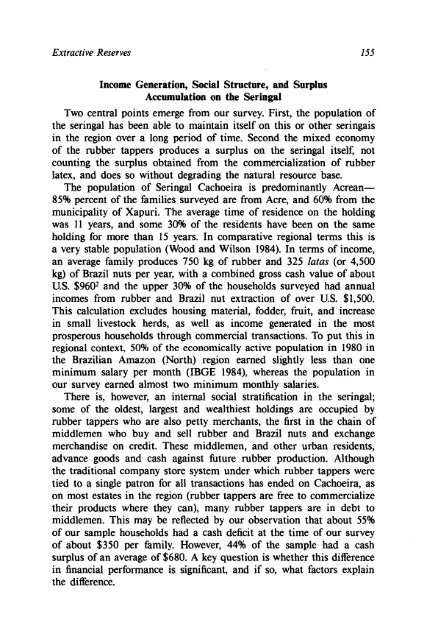Fragile Lands of Latin America Strategies for ... - PART - USAID
Fragile Lands of Latin America Strategies for ... - PART - USAID
Fragile Lands of Latin America Strategies for ... - PART - USAID
Create successful ePaper yourself
Turn your PDF publications into a flip-book with our unique Google optimized e-Paper software.
Extractive Reserves<br />
Income Generation, Social Structure, and Surplus<br />
Accumulation on the Ser ingal<br />
Two central points emerge from our survey. First, the population <strong>of</strong><br />
the seringal has been able to maintain itself on this or other seringais<br />
in the region over a long period <strong>of</strong> time. Second the mixed economy<br />
<strong>of</strong> the rubber tappers produces a surplus on the seringal itself, not<br />
counting the surplus obtained from the commercialization <strong>of</strong> rubber<br />
latex, and does so without degrading the natural resource base.<br />
The population <strong>of</strong> Seringal Cachoeira is predominantly Acrean-<br />
85% percent <strong>of</strong> the families surveyed are from Acre, and 60% from the<br />
municipality <strong>of</strong> Xapuri. The average time <strong>of</strong> residence on the holding<br />
was 11 years, and some 30% <strong>of</strong> the residents have been on the same<br />
holding <strong>for</strong> more than 15 years. In comparative regional terms this is<br />
a very stable population (Wood and Wilson 1984). In terms <strong>of</strong> income,<br />
an average family produces 750 kg <strong>of</strong> rubber and 325 latas (or 4,500<br />
kg) <strong>of</strong> Brazil nuts per year, with a combined gross cash value <strong>of</strong> about<br />
U.S. $9602 and the upper 30% <strong>of</strong> the households surveyed had annual<br />
incomes from rubber and Brazil nut extraction <strong>of</strong> over U.S. $1,500.<br />
This calculation excludes housing material, fodder, fruit, and increase<br />
in small livestock herds, as well as income generated in the most<br />
prosperous households through commercial transactions. To put this in<br />
regional context, 50% <strong>of</strong> the economically active population in 1980 in<br />
the Brazilian Amazon (North) region eamed slightly less than one<br />
minimum salary per month (IBGE 1984), whereas the population in<br />
our survey eamed almost two minimum monthly salaries.<br />
There is, however, an internal social stratification in the seringal;<br />
some <strong>of</strong> the oldest, largest and wealthiest holdings are occupied by<br />
rubber tappers who are also petty merchants, the first in the chain <strong>of</strong><br />
middlemen who buy and sell rubber and Brazil nuts and exchange<br />
merchandise on credit. These middlemen, and other urban residents,<br />
advance goods and cash against future rubber product ion. A1 though<br />
the traditional company store system under which rubber tappers were<br />
tied to a single patron <strong>for</strong> all transactions has ended on Cachoeira, as<br />
on most estates in the region (rubber tappers are free to commercialize<br />
their products where they can), many rubber tappers are in debt to<br />
middlemen. This may be reflected by our observation that about 55%<br />
<strong>of</strong> our sample households had a cash deficit at the time <strong>of</strong> our survey<br />
<strong>of</strong> about $350 per family. However, 44% <strong>of</strong> the sample had a cash<br />
surplus <strong>of</strong> an average <strong>of</strong> $680. A key question is whether this difference<br />
in financial per<strong>for</strong>mance is significant, and if so, what factors explain<br />
the difference.

















